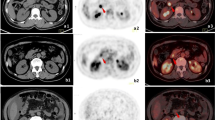Abstract
Purpose
This study aimed to evaluate the fluorodeoxyglucose positron emission tomography/computed tomography (FDG-PET/CT) findings and pattern of FDG uptake in pancreatic metastases.
Materials and methods
A total of 19 consecutive patients (26 lesions) with histologically or clinically confirmed pancreatic metastases who had undergone 18F-FDG-PET/CT were enrolled in this retrospective study. Among the 19 patients, 14 patients underwent abdominal contrast-enhanced CT (ceCT). The location, size and FDG uptake patterns of the pancreatic lesions were recorded. Metabolic activity by means of maximum standardised uptake value (SUVmax) was measured by drawing regions of interest at the site of pancreatic lesions. Twenty pancreatic cancer patients were included in this study as comparative data analysis. The difference of SUVmax between pancreatic metastases and primary pancreatic cancer were compared using the Mann–Whitney U test. P < 0.05 was considered significant.
Results
Three different patterns of FDG uptake could be distinguished in the pancreatic metastatic lesions, including focal nodule or mass, multiple foci and segmental lesion with high FDG uptake. The average SUVmax in pancreatic metastases was 7.8 ± 6.9 versus 7.4 ± 3.9 in primary pancreatic cancer (P = 0.987 > 0.05). Four intrapancreatic isodense nodules in three patients were undetected on ceCT.
Conclusion
The described patterns of FDG uptake findings may be helpful for a better characterisation of pancreatic metastases although semiquantitative analysis using SUVmax could not be used as a criterion for differentiating pancreatic metastases from primary pancreatic cancer. FDG-PET/CT has also an advantage in detecting unsuspected pancreatic metastases which cannot be detected by ceCT imaging. Thus, it is a useful adjunct to the described features on CT.






Similar content being viewed by others
References
Crippa S, Angelini C, Mussi C et al (2006) Surgical treatment of metastatic tumor to the pancreas: a single center experience and a review of the literature. Word J Surg 30:1536–1542
Zerbi A, Ortolano E, Balzano G et al (2008) Pancreatic metastasis from renal cell carcinoma: which patients benefit from surgical resection? Ann Surg Oncol 15:1161–1168
Tsitouridis I, Diamantopoulou A, Michaelides M et al (2010) Pancreatic metastases: CT and MRI findings. Diagn Interv Radiol 16:45–51
Sperti C, Pasquali C, Liessi G et al (2003) Pancreatic resection for metastatic tumors to the pancreas. J Surg Oncol 83:161–166
Angelelli G, Mancini M, Pignataro P et al (2012) Multidetector computed tomography in the study of pancreatic metastases. Radiol Med 117:369–377
Corwin MT, Lamba R, Wilson M et al (2013) Renal cell carcinoma metastases to the pancreas: value of arterial phase imaging at MDCT. Acta Radiol 54:349–354
Bhushan Desai MBBS, Elatre Wafaa et al (2011) FDG PET/CT demonstration of pancreatic metastasis from prostate cancer. Clin Nucl Med 36:961–962
Borschitz T, Eichhorn W, Fottner C et al (2010) Diagnosis and treatment of pancreatic metastases of a papillary thyroid carcinoma. Thyroid 20:3–98
Lam WW, Loke KS, Loi HY et al (2011) Pancreatic metastasis detected by F-18 FDG PET/CT in a patient with breast cancer. Clin Nucl Med 36:479–480
Sato M, Okumura T, Kaito K et al (2009) Usefulness of FDG-PET/CT in the detection of pancreatic metastases from lung cancer. Ann Nucl Med 23:49–57
Jha P, Frölich AM, McCarville B et al (2010) Unusual association of alveolar rhabdomyosarcoma with pancreatic metastasis: emerging role of PET–CT in tumor staging. Pediatr Radiol 40:1380–1386
Sellner F, Tykalsky N, De Santis M et al (2006) Solitary and multiple isolated metastases of clear cell renal carcinoma to the pancreas: an indication for pancreatic surgery. Ann Surg Oncol 13:75–85
McCarville MB, Christie R, Daw NC et al (2005) PET/CT in the evaluation of childhood sarcomas. AJR Am J Roentgenol 184:1293–1304
Liratzopoulos N, Efremidou EI, Papageorgiou MS et al (2006) Extrahepatic biliary obstruction due to a solitary pancreatic metastasis of squamous cell lung carcinoma: case report. J Gastrointest Liver Dis 15:73–75
Ferrozzi F, Bova D, Campodonico F et al (1997) Pancreatic metastases: CT assessment. Eur Radiol 7:241–245
Dong A, Dong H, Zhang L, Zuo C (2013) Hypermetabolic lesions of the pancreas on FDG PET/CT. Clin Nucl Med 38:354–366
Lopez Hänninen E, Amthauer H, Hosten N et al (2002) Prospective evaluation of pancreatic tumors: accuracy of MR imaging with MR cholangiopancreatography and MR angiography. Radiology 224:34–41
Tan CH, Tamm EP, Marcal L et al (2011) Imaging features of hematogenous metastases to the pancreas: pictorial essay. Cancer Imaging 11:9–15
Lewis RB, Lattin GE Jr, Paal E (2010) Pancreatic endocrine tumors: radiologic–clinicopathologic correlation. Radiographics 30:1445–1464
Rufini V, Baum RP, Castaldi P et al (2012) Role of PET/CT in the functional imaging of endocrine pancreatic tumors. Abdom Imaging 37:1004–1020
Proctor RD, Rofe CJ, Bryant TJ et al (2013) Autoimmune pancreatitis: an illustrated guide to diagnosis. Clin Radiol 68:422–432
Kamisawa T, Takum K, Anjiki H, Egawa N et al (2010) FDG-PET/CT findings of autoimmune pancreatitis. Hepatogastroenterology 57:447–450
Zhang J, Shao C, Wang J et al (2013) Autoimmune pancreatitis: whole-body 18F-FDG PET/CT findings. Abdom Imaging 38:543–549
Acknowledgments
This study was supported by the National Nature Science Foundation of China, No. 81170435 and the Shanghai Leading Talent Team Construction Special Funds, No. 2011-036.
Conflict of interest
The authors declare no conflict of interest.
Author information
Authors and Affiliations
Corresponding author
Additional information
S. Hu and J. Zhang contributed equally to this article.
Rights and permissions
About this article
Cite this article
Hu, S., Zhang, J., Zuo, C. et al. 18F-FDG-PET/CT findings in pancreatic metastasis. Radiol med 120, 887–898 (2015). https://doi.org/10.1007/s11547-014-0473-1
Received:
Accepted:
Published:
Issue Date:
DOI: https://doi.org/10.1007/s11547-014-0473-1




